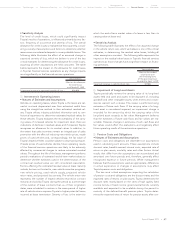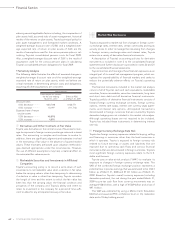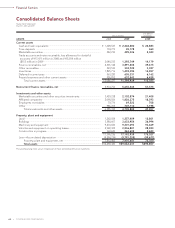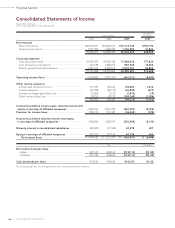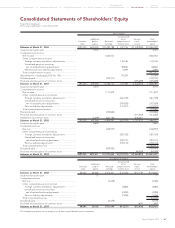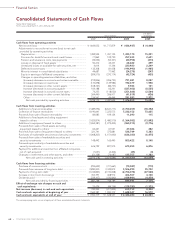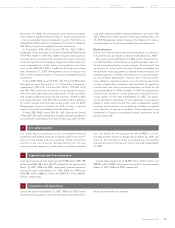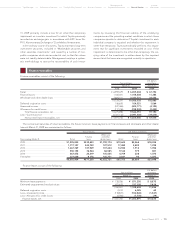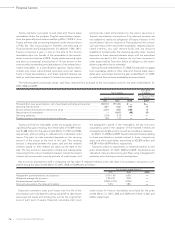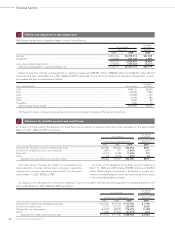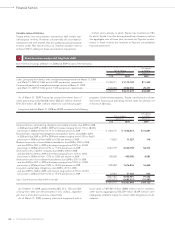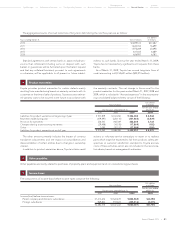Toyota 2009 Annual Report Download - page 73
Download and view the complete annual report
Please find page 73 of the 2009 Toyota annual report below. You can navigate through the pages in the report by either clicking on the pages listed below, or by using the keyword search tool below to find specific information within the annual report.
The Right Way Forward Business OverviewPerformance Overview Financial Section
Investor
Information
Management &
Corporate Information
Top Messages
Annual Report 2009 71
Property, plant and equipment
Property, plant and equipment are stated at cost. Major renew-
als and improvements are capitalized; minor replacements,
maintenance and repairs are charged to current operations.
Depreciation of property, plant and equipment is mainly
computed on the declining-balance method for the parent com-
pany and Japanese subsidiaries and on the straight-line method
for foreign subsidiary companies at rates based on estimated
useful lives of the respective assets according to general class,
type of construction and use. The estimated useful lives range
from 2 to 65 years for buildings and from 2 to 20 years for
machinery and equipment.
Vehicles and equipment on operating leases to third parties
are originated by dealers and acquired by certain consolidated
subsidiaries. Such subsidiaries are also the lessors of certain
property that they acquire directly. Vehicles and equipment on
operating leases are depreciated primarily on a straight-line
method over the lease term, generally 5 years, to the estimated
residual value.
Long-lived assets
Toyota reviews its long-lived assets for impairment whenever
events or changes in circumstances indicate that the carrying
amount of an asset group may not be recoverable. An impair-
ment loss would be recognized when the carrying amount of an
asset group exceeds the estimated undiscounted cash flows
expected to result from the use of the asset and its eventual dis-
position. The amount of the impairment loss to be recorded is
calculated by the excess of the carrying value of the asset group
over its fair value. Fair value is determined mainly using a dis-
counted cash flow valuation method.
Goodwill and intangible assets
Goodwill is not material to Toyota’s consolidated balance
sheets.
Intangible assets consist mainly of software. Intangible assets
with a definite life are amortized on a straight-line basis with
estimated useful lives mainly of 5 years. Intangible assets with
an indefinite life are tested for impairment whenever events or
circumstances indicate that a carrying amount of an asset (asset
group) may not be recoverable. An impairment loss would be
recognized when the carrying amount of an asset exceeds the
estimated undiscounted cash flows used in determining the fair
value of the asset. The amount of the impairment loss to be
recorded is generally determined by the difference between the
fair value of the asset using a discounted cash flow valuation
method and the current book value.
Employee benefi t obligations
Toyota has both defined benefit and defined contribution plans
for employees’ retirement benefits. Retirement benefit obliga-
tions are measured by actuarial calculations in accordance with
a Statement of Financial Accounting Standards (“FAS”) No. 87
Employers’ Accounting for Pensions (“FAS 87”). Toyota adopted
the provisions regarding recognition of funded status and dis-
closure under FAS No. 158, Employers’ Accounting for Defined
Benefit Pension and Other Postretirement Plans—an amend-
ment of FASB Statements No. 87, 88, 106, and 132(R) (“FAS 158”)
as of March 31, 2007. Under the provisions of FAS 158, the over-
funded or underfunded status of the defined benefit postretire-
ment plans is recognized on the consolidated balance sheets as
prepaid pension and severance costs or accrued pension and
severance costs, and the funded status change is recognized in
the year in which it occurs through comprehensive income. Prior
to the adoption of FAS 158, a minimum pension liability had
been recorded for plans where the accumulated benefit obliga-
tion net of plan assets exceeded the accrued pension and sev-
erance costs. After the adoption of FAS 158, a minimum pension
liability is not recorded.
Environmental matters
Environmental expenditures relating to current operations are
expensed or capitalized as appropriate. Expenditures relating to
existing conditions caused by past operations, which do not
contribute to current or future revenues, are expensed. Liabilities
for remediation costs are recorded when they are probable and
reasonably estimable, generally no later than the completion of
feasibility studies or Toyota’s commitment to a plan of action.
The cost of each environmental liability is estimated by using
current technology available and various engineering, financial
and legal specialists within Toyota based on current law. Such
liabilities do not reflect any offset for possible recoveries from
insurance companies and are not discounted. There were no
material changes in these liabilities for all periods presented.
Income taxes
The provision for income taxes is computed based on the pre-
tax income included in the consolidated statement of income.
The asset and liability approach is used to recognize deferred
tax assets and liabilities for the expected future tax consequenc-
es of temporary differences between the carrying amounts and
the tax bases of assets and liabilities. Valuation allowances are
recorded to reduce deferred tax assets when it is more likely
than not that a tax benefit will not be realized.
Derivative fi nancial instruments
Toyota employs derivative financial instruments, including for-
ward foreign currency exchange contracts, foreign currency
options, interest rate swaps, interest rate currency swap agree-
ments and interest rate options to manage its exposure to fluc-
tuations in interest rates and foreign currency exchange rates.
Toyota does not use derivatives for speculation or trading pur-
poses. Changes in the fair value of derivatives are recorded
each period in current earnings or through other comprehensive
income, depending on whether a derivative is designated as
part of a hedge transaction and the type of hedge transaction.
The ineffective portion of all hedges is recognized currently in
operations.


